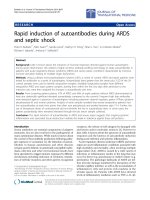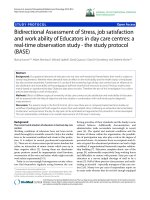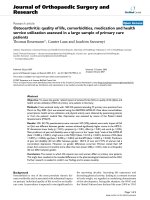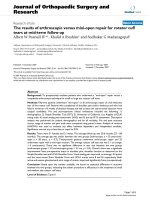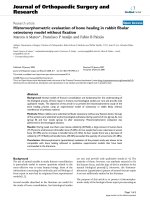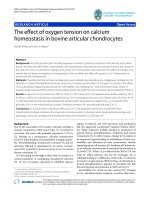Báo cáo hóa học: " Microwave-Assisted Synthesis of Titania Nanocubes, Nanospheres and Nanorods for Photocatalytic Dye Degradation" pptx
Bạn đang xem bản rút gọn của tài liệu. Xem và tải ngay bản đầy đủ của tài liệu tại đây (864.04 KB, 9 trang )
NANO EXPRESS
Microwave-Assisted Synthesis of Titania Nanocubes, Nanospheres
and Nanorods for Photocatalytic Dye Degradation
T. Suprabha Æ Haizel G. Roy Æ Jesty Thomas Æ
K. Praveen Kumar Æ Suresh Mathew
Received: 4 September 2008 / Accepted: 11 November 2008 / Published online: 26 November 2008
Ó to the authors 2008
Abstract TiO
2
nanostructures with fascinating morphol-
ogies like cubes, spheres, and rods were synthesized by a
simple microwave irradiation technique. Tuning of different
morphologies was achieved by changing the pH and the
nature of the medium or the precipitating agent. As-synthe-
sized titania nanostructures were characterized by X-ray
diffraction (XRD), UV–visible spectroscopy, infrared
spectroscopy (IR), BET surface area, photoluminescence
(PL), scanning electron microscopy (SEM) and transmission
electron microscopy (TEM), and atomic force microscopy
(AFM) techniques. Photocatalytic dye degradation studies
were conducted using methylene blue under ultraviolet light
irradiation. Dye degradation ability for nanocubes was found
to be superior to the spheres and the rods and can be attrib-
uted to the observed high surface area of nanocubes. As-
synthesized titania nanostructures have shown higher pho-
tocatalytic activity than the commercial photocatalyst
Degussa P25 TiO
2
.
Keywords Nanocubes Á Nanorods Á Nanospheres Á
Photocatalytic activity Á Microwave irradiation Á
Dye degradation
Introduction
Nanomaterials of transition metal oxides have attracted a
great deal of attention from researchers in various fields due
to their numerous technological applications [1–4]. Among
them, nanocrystalline titania has been attracting increasing
attention due to its fascinating properties and potential
applications. Titanium dioxide is a versatile material which
is being investigated extensively due to its unique opto-
electronic and photochemical properties such as high
refractive index, high dielectric constant, excellent optical
transmittance in the visible and near IR regions as well as its
high performance as a photocatalyst for water splitting and
degradation of organics [5]. With a band gap of 3.0–3.3 eV,
titanium dioxide has been photocatalytically active only
under ultraviolet light (wavelength k \ 400 nm) [6]. Tita-
nium dioxide mainly exists in three crystalline phases:
anatase, rutile, and brookite [7]. Among the three crystalline
forms, anatase titanium dioxide is attracting more attention
for its vital use as pigments [8], gas sensors [9], catalysts [10,
11], photocatalysts [12–14] in response to its application in
environmentally related problems of pollution control and
photovoltaics [15]. The properties and catalytic activities of
titania strongly depend upon the crystallinity, surface mor-
phology, particle size, and preparation methods. The
increased surface area of nanosized TiO
2
particles may
prove beneficial for the decomposition of dyes in aqueous
media. Ohtani et al. [16] proposed that high photocatalytic
activity of titania can be achieved by imparting large surface
area to adsorb substrates and by making high crystallinity to
minimize the photoexcited electron-hole recombination
rate. In general anatase titania is observed to be more active
compared to its rutile phase. This difference in activity can
be due to the high electron-hole recombination rate observed
in rutile titania. Many synthetic methods have been reported
for the preparation of nanotitania, including sol–gel reac-
tions [17–19], hydrothermal reactions [20, 21], non-
hydrolytic sol–gel reactions [22, 23], template methods [24–
26], reactions in reverse micelles [27], and microwave
irradiation. Nanotitania with various morphologies and
shapes such as nanorods [28], nanotubes [29, 30], nanowires
T. Suprabha Á H. G. Roy Á J. Thomas Á K. Praveen Kumar Á
S. Mathew (&)
School of Chemical Sciences, Mahatma Gandhi University,
Kottayam 686 560, Kerala, India
e-mail:
123
Nanoscale Res Lett (2009) 4:144–152
DOI 10.1007/s11671-008-9214-5
[31, 32], and nanospheres [33, 34] can be produced
depending upon the synthetic method used. These different
morphologies have different photocatalytic activities. In
the present work, we report a simple microwave method
to synthesize phase pure anatase and rutile nanotitania
with different morphologies viz., cubes, spheres, and rods.
Photocatalytic activity studies of the synthesized samples
were carried out using the dye, methylene blue in aqueous
solution under ultraviolet light irradiation. The photo-
luminescence (PL) features of the synthesized titania
nanostructures were also compared in the present study.
Experimental
Materials
All reagents were purchased from Merck, Germany. Tita-
nium trichloride (15 wt% TiCl
3
, 10 wt% HC1) was used as
the titanium precursor. NH
4
OH (1.5 M), NaCl (5.0 M), and
NH
4
Cl (5.0 M) were employed for the synthesis. A typical
microwave oven (Whirlpool, 1200W) operating at a fre-
quency of 2,450 MHz was used for the synthesis.
Synthesis of TiO
2
Nanostructures
A general synthetic strategy adopted for the synthesis of
titania nanostructures was using TiCl
3
as Ti precursor by
varying the precipitating agents under different pH condi-
tions. The precipitated sol was irradiated in a microwave
oven in on and off mode for different durations depending
upon the precipitation rate in each case. The completion of
the reaction is checked by noting the color change (blue to
colorless) of the reaction mixture. The white precipitate
formed in each case was aged for 24 h and washed thor-
oughly with distilled water. The precipitated titania was
then dried in an air oven at 100 °C and further calcined in a
muffle furnace at 400 °C for 4 h.
In the case of sample 1 (S1) TiCl
3
(20.0 mL) was added
drop by drop to 200 mL of 1.5 M NH
3
(pH = 11) solution
[35] and the irradiation was done for 20 min for complete
precipitation. In sample 2 (S2), TiCl
3
(5.0 mL) was added
dropwise with continuous stirring to 200 mL of 5.0 M
NaCl solution (pH = 7) [36] and the reaction mixture was
irradiated for 60 min for complete precipitation. In sample
3 (S3), TiCl
3
(5.0 mL) was added dropwise to 200 mL of
5.0 M NH
4
Cl solution (pH = 5.9) and irradiated in a
similar manner as in the previous case for 60 min.
Characterization of Titania Nanostructures
The X-ray diffraction (XRD) patterns of the titania were
recorded on a Brucker D8 advance diffractometer with
CuK
a
radiation. The crystallite size of TiO
2
was calculated
using Debye Scherrer equation, L = kk/(bcosh), where L is
the average crystallite size, k is the wavelength of the
radiation, h is the Bragg’s angle of diffraction, b is the full
width at half maximum intensity of the peak and k is a
constant usually applied as *0.89. Scanning electron
microscopic images were taken on a JEOL JSM-5600 SEM
equipped with energy dispersive X-ray analysis (EDX).
High resolution transmission electron micrographs and
electron diffraction patterns were recorded using a JEOL
JEM-3010 HRTEM microscope at an accelerating voltage
of 300 kV. The TEM specimens were prepared by drop
casting the sample on the surface of the carbon coated
copper grid. The tapping mode AFM images of the samples
deposited on a mica sheet were taken using Nanoscope-IV
scanning probe microscope. The BET surface area, pore
size distribution, and pore volume of the samples were
measured on a Micromeritics ASAP 2010 analyzer based
on N
2
adsorption at 77 K in the pressure range from 0.1 to
760 mmHg. The pore size distribution was calculated by
the Barrett Joyner Halenda (BJH) method. IR spectra was
recorded using Shimadzu 8400S FTIR spectrophotometer
in the range of 400–4,000 cm
-1
. The ultraviolet–visible
absorption (UV–vis) spectra were recorded using a UV-
2450 Shimadzu UV–visible spectrophotometer. The pho-
toluminescence (PL) spectral measurements were made
using Perkin Elmer LS-55 luminescence spectrometer at an
excitation wavelength of 325 nm.
Photocatalytic Activity Measurements
Photocatalytic activity of TiO
2
was evaluated by the deg-
radation of the dye, methylene blue (MB) in aqueous
solution under ultraviolet light irradiation in the presence
of as-synthesized TiO
2
and the commercial Degussa P25
TiO
2
. The changes in the concentrations of methylene blue
in the aqueous solution were examined by absorption
spectra measured on a UV-2450 Shimadzu UV–visible
spectrophotometer. Before examining the photocatalytic
activity for degradation of aqueous methylene blue, TiO
2
sol was prepared. About 100 mg of the synthesized TiO
2
was dispersed ultrasonically in 50 mL of deionized water.
For photodegradation experiments, 50 mL of 4 9 10
-5
M
methylene blue solution was added to the as-synthesized
titania sol in a quartz reactor. To maximize the adsorption
of the dye onto the TiO
2
surface, the resulting mixture was
kept in the dark for 30 min under stirring conditions [37].
The solution was then irradiated for 180 min using a
mercury lamp (100 W, Toshiba SHLS-1002 A). The deg-
radation of the dye was monitored by measuring the
absorption maximum of methylene blue at 661 nm at
30 min intervals of reaction.
Nanoscale Res Lett (2009) 4:144–152 145
123
Results and Discussion
X-ray Diffraction Studies
The X-ray diffraction (XRD) patterns (Fig. 1) of the TiO
2
particles show that anatase phase is formed when NH
4
OH
(S1) is used whereas the formation of rutile phase is
observed when the medium is NaCl (S2) and NH
4
Cl (S3).
The average crystallite size of the S1, S2, and S3 are 12,
10, and 21 nm, respectively. XRD powder pattern of S1
corresponds to anatase phase with lattice constants,
a = 3.777 A
˚
and c = 9.501 A
˚
as reported in JCPDS file
no. 89-4921. All the peaks in S2 and S3 can be readily
indexed to rutile phase with lattice constants a = 4.608 A
˚
,
c = 2.973 A
˚
and a = 4.548 A
˚
,c= 2.946 A
˚
, respectively,
as reported in JCPDS files, no. 76-0319 and 88-1173. The
d-spacing from HRTEM is consistent with the d-spacing
from XRD results. The absence of any other peak indicates
the phase purity of the synthesized titania.
BET Surface Area Analysis
Figure 2 shows the N
2
adsorption and desorption isotherms
of the three titania samples with their corresponding pore
size distribution (BJH method) (inset). Type IV isotherm
observed with a clear hysteresis at relatively low pressure
indicates the mesoporous nature of the sample S1 [38].
Pore size distribution also confirms the mesoporous nature
indicating an average pore size around 4 nm. For samples
S2 and S3 the hysteresis moves to relatively high pressure
indicating a still narrower pore size and is around 2.5 and
2 nm, respectively, as observed from pore size distribution.
20 30 40 50 60
(S3)
(S1)
(S2)
(105)
(200)
(004)
(101)
(200)
(211)
(210)
(111)
(101)
(110)
2θ (degree)
Intensity (a.u.)
Fig. 1 XRD powder patterns of titania synthesized in different
medium (S1) NH
4
OH, (S2) NaCl, and (S3) NH
4
Cl
0.0 0.2 0.4 0.6 0.8 1.0
60
80
100
120
140
160
180
200
0 20406080100120140
-2
0
2
4
6
8
10
12
14
16
Pore Volumex 10
-3
(cm
3
g
-1
)
Pore Diameter (Å)
(a)
Volume adsorbed (cm
3
g
-1
)
Relative Pressure (P/P
0
)
0.0 0.2 0.4 0.6 0.8 1.0
0
50
100
150
200
250
300
(b)
0 20406080100120140
0.0
0.5
1.0
1.5
2.0
2.5
3.0
Pore Volumex 10
-4
(cm
3
g
-1
)
Pore Diameter (Å)
Volume adsorbed (cm
3
g
-1
)
Relative Pressure (P/P
0
)
0.0 0.2 0.4 0.6 0.8 1.0
0
10
20
30
40
50
60
70
80
0 20406080100120140
0
2
4
6
8
10
12
Pore Volumex 10
-5
(cm
3
g
-1
)
Pore Diameter (Å)
(c)
Relative Pressure (P/P
0
)
Volume adsorbed (cm
3
g
-1
)
Fig. 2 N
2
adsorption–
desorption isotherms and pore
size distribution of the
synthesized nanotitania (inset) a
S1, b S2, and c S3
146 Nanoscale Res Lett (2009) 4:144–152
123
The crystallite size, BET surface area, pore size, and pore
volume values are summarized in Table 1. The surface
area of S1, S2, and S3 are 372, 77, and 34 m
2
g
-1
,
respectively.
Electron Microscopic Analysis
SEM images of titania samples are given in Fig. 3. S1 (a),
S2 (b), and S3 (c) show a cube-like morphology, spherical
morphology, and rod-like morphology, respectively.
Agglomerated particles are observed in the SEM images
[39]. The high resolution TEM images of the TiO
2
nano-
particles synthesized under various reaction conditions are
shown in Fig. 4. TEM image of S1 (a) shows the formation
of nanocubes with particle size around 25 nm. The
HRTEM image (b) shows lattice fringes of the anatase
phase. The fringes with d = 0.34 nm match with that of
the (101) crystallographic plane of anatase titania. The
selected area electron diffraction pattern in the inset of the
A confirms that the sample S1 is a single crystalline anatase
phase. The high surface area observed for the sample S1
may be due to the highly porous nature of the cubes. Since
the sample S1 is not an ordered mesoporous system,
mesopores cannot be viewed clearly from HRTEM images.
Sample S2 (c) shows the formation of nanospheres of
average crystallite size around 8 nm. Corresponding
selected area electron diffraction pattern is shown in the
inset. The pattern indicates the polycrystalline nature of the
sample. Lattice image (d) of these nanospheres shows
lattice fringes of the rutile phase with d = 0.32 nm, which
matches well with that of (110) plane of rutile titania.
Sample S3 (e) shows the formation of nanorods with an
average aspect ratio of around 4 nm. Corresponding SAED
pattern indicates a polycrystalline nature, which may be
due to the diffraction in a bunch of nanorods. The HRTEM
image (f) of the rutile nanorods show clear lattice fringes of
the rutile phase with d = 0.32 nm, which matches with
that of the (110) plane of rutile titania. The TEM results
reveal that nano TiO
2
with different morphologies like
cubes, spheres, and rods can be effectively synthesized by
varying the pH in an appropriate media. Figure 5 shows the
tapping mode AFM images of the titania cubes (S1),
spheres (S2), and rods (S3) which is in good agreement
with that of the TEM results [40].
Spectroscopic Analysis
The FTIR spectra of S1, S2, and S3 are shown in Fig. 6.
The FTIR spectra shows a broadband around 3,400 cm
-1
,
which is attributed to the O–H stretching mode of the
surface adsorbed water molecule. Another band of around
1,600 cm
-1
is attributed to the O–H bending mode. The
bands around 400–900 cm
-1
are due to the Ti–O bond
stretching mode of the titania [41–45].
Optical Properties
UV–Visible Absorption Studies
Figure 7 shows the UV-vis absorption spectra of titania
nanostructures S1, S2, and S3. The onset of absorption for
the three samples is 382, 405, and 415 nm for S1, S2, and
S3, respectively. To determine the nature of the band gap,
either an indirect or a direct transition, the following power
expression for the variation of the absorption coefficient (a)
with energy was examined [46, 47].
ahtðÞ
n
¼ k
id
ht ÀE
g
ÀÁ
where k
id
is the absorption constant for an indirect (sub-
script i) or direct (subscript d) transition, n is two for an
indirect transition and for a direct transition, ht is the
absorption energy, and E
g
is the band gap energy. The
absorption coefficient (a) was determined from the equa-
tion a = (2.303 9 10
3
)(A)/l by using the measured
absorbance (A) and optical path length (l) (1 cm). The band
gap (E
g
) of a semiconductor can be estimated from the plot
of (ahm)
2
versus photon energy (hm). The band gap energy
is determined by extrapolating the curve to the x-axis, as
shown in the Fig. 8 [48]. Variation of (ahm)
2
with
Table 1 Textural analysis of mesoporous TiO
2
Nanostructures
Sample
code
Crystallite
size from
XRD (nm)
BET surface
area (m
2
g
-1
)
Pore
size (nm)
Pore volume
(cm
3
g
-1
)
S1 12 372 4 0.37
S2 10 77 2.5 0.18
S3 21 34 2 0.10
Fig. 3 SEM images of samples
S1 (a), S2 (b) and S3 (c)
Nanoscale Res Lett (2009) 4:144–152 147
123
absorption energy (hm) for nanocubes (Fig. 8) gives the
extrapolated intercept corresponding to the band gap
energy at 3.2 eV, which is in agreement to the onset energy
observed in the absorption spectrum, confirming that the
band gap is attributed to the indirect transition. The band
gap energy of nanocubes (S1) is significantly higher as
compared to that of nanospheres (S2, 3.17 eV) and nano-
rods (S3, 3.15 eV). For pure anatase, the significant
increase in the absorption wavelength (k) (lower than
380 nm) can be assigned to the intrinsic band gap
absorption [49]. The band gap (E
g
) is estimated to be
3.2 eV, which is in good agreement with the reported value
for anatase (3.2–3.3 eV). The absorption spectrum of rutile
shows a lower absorption and the calculated band gap is
around 3.17 and 3.15 eV, respectively, for the samples S2
and S3. However, rutile nanostructures show a slightly
higher band gap than the reported value (3.0–3.1 eV). The
higher band gap may be due to the smaller particle size.
The band gap (E
g
) and absorption onset (k max) values are
summarized in Table 2.
Fig. 4 HRTEM images of:
a S1 (nanocubes) and b
corresponding lattice; d S2
(nanospheres) and e
corresponding lattice; g S3
(nanorods) and h corresponding
lattice image. The inset of the
figure a, d and g represents the
selected area electron
diffraction pattern of the titania
nanostructures
Fig. 5 Tapping AFM
micrographs of S1 (a), S2 (b),
and S3 (c)
148 Nanoscale Res Lett (2009) 4:144–152
123
Photoluminescence Studies
Figure 9 shows the photoluminescence (PL) emission
spectra of titania nanostructures measured at room
temperature. The PL emission spectra are observed with an
excitation wavelength around 325 nm, exhibiting a strong
structural emission band around 360 nm with broad
shoulders beyond 380 nm. At a higher wavelength around
500 nm emission due to the trapped or excess surface states
is observed. The excited state of TiO
2
can be considered as
Ti
3?
…O
-
and the subsequent emission may be due to the
transfer of electron from the excited state (Ti
3?
)to(O
-
)
leading to the formation of Ti
4?
O
2
2-
. Therefore the strong
emission in the region of 360–363 nm is assigned to the
exciton emission originating from the recombination of a
hole with an electron, whereas the weak and broad emis-
sion peaks in the region of 400–500 nm is just a surface
state emission originating from the trapped or excess sur-
face states [50–52].
4000 3000 2000
1000
0
20
40
60
80
100
120
Ti-O stretch
O-H bend
O-H stretch
S3
S2
S1
% Transmittance
Wavenumber (cm
-1
)
Fig. 6 FTIR spectra of TiO
2
samples S1, S2, and S3
3.0 3.2 3.4 3.6 3.8 4.0
0
1
2
3
4
5
6
S1
(
αh
ν
)
2
x 10
-
36
Eg = 3.20 eV
Bandgap (Eg) (eV)
3.03.23.43.63.8
0
1
2
3
4
5
S2
(αhν)
2
x10
-36
Eg = 3.17 eV
Bandgap (Eg) (eV)
3.0 3.2 3.4 3.6
0.0
0.5
1.0
1.5
2.0
2.5
S3
Eg = 3.15 eV
(αhν)
2
x10
-36
Bandgap (Eg) (eV)
Fig. 8 A plot of (aht)
2
versus
photon energy (ht) of the
synthesized nanotitania
Table 2 Summary of band gap and absorption onset of the synthe-
sized nanotitania
Sample
code
Band gap
(E
g
)eV
Absorption
onset (k
max
)
S1 3.20 382
S2 3.17 405
S3 3.15 415
350 400 450 500
S3
S2
S1
Intensity (a.u.)
Wavelength (nm)
Fig. 9 PL emission spectra of titania nanostructures S1, S2, and S3
250 300 350 400 450 500
S3
S1
S2
Absorbance (a.u.)
Wavelength (nm)
Fig. 7 UV–visible absorption spectra of titania samples S1, S2, and
S3
Nanoscale Res Lett (2009) 4:144–152 149
123
Mechanistic Aspects
Three different morphologies obtained under Microwave
(MW) irradiation can be understood in different ways. It
may be due to the fast nucleation of Ti(OH)
2
under three
different pH (basic, neutral and acidic) and its subsequent
condensation during reaction, dehydration and calcination.
Morphology difference can be attributed to the ion assisted
growth of the crystallites which may be different for OH
-
assisted growth in the case of S1 and Cl
-
assisted growth in
S2 and Cl
-
and NH
4
?
assisted growth in S3. The shape
evolution originates from the different adsorption capabil-
ities of theses ions in various planes during the growth of
the particle [53]. A schematic of shape tuning achieved
during the synthesis under three different pH is shown in
Scheme 1.
Photocatalytic Activity Studies
Photocatalytic processes involve irradiation of a semicon-
ductor such as TiO
2
with energy greater than or equal to the
band gap of the semiconductor. This promotes electrons
from the valence band to the conduction band, generating
photoexcited electrons (e
-
) and holes (h
?
). The photoex-
cited electrons and holes may diffuse to the surface of the
semiconductor, followed by interfacial electron transfer to
and from the adsorbed acceptor and donor molecules. The
holes are involved in the oxidation reactions, typically the
mineralization of organic substances present in the solution
[54]. In the present work, photocatalytic activity tests were
conducted by the degradation of the dye, methylene blue in
aqueous solution under ultraviolet light irradiation. Meth-
ylene blue (MB) shows a maximum absorption at 661 nm.
The absorption peak gradually diminishes upon the ultra-
violet light irradiation, illustrating the methylene blue
degradation. The concentrations of methylene blue with
irradiation time for the three titania nanostructures,
Degussa P25 and methylene blue are shown in Fig. 10.Itis
clear that the anatase titania nanocubes (S1) shows higher
photocatalytic activity than the other two rutile nano-
structures (S2 and S3). From the degradation studies, it is
observed that the photocatalytic activity varies in the order
S1 [ S2 [ S3 [ Degussa P25. The three nanostructures
synthesized in different media have different phase struc-
ture, particle size, and surface area. It is reported that
among the three crystalline phases of TiO
2
, the anatase
phase has higher photocatalytic activity [55]. The differ-
ence in activity of the synthesized samples is related to
their surface area, particle size, and phase. Small crystallite
size and mesoporous texture produces high surface area
TiO
2
and hence can provide more active sites and adsorb
more reactive species. Since S1 is purely anatase phase and
has the highest surface area among the three samples, it
exhibits the highest photocatalytic activity. The apprecia-
ble activity observed for the nanorods (34 m
2
/g) compared
to Degussa P25 (50 m
2
/g) may be due to the preferentially
grown 110 planes in the nanorod morphology.
Scheme 1 A schematic of shape tuning achieved by ion assisted
growth for titania nanostructures in different pH
30 60 90 120 150 180
0.0
0.2
0.4
0.6
0.8
1.0
MB
Degussa P25
S3
S2
S1
C
t
/C
o
Time (min)
Fig. 10 Photocatalytic activity of various TiO
2
nanostructures for the
degradation of methylene blue
150 Nanoscale Res Lett (2009) 4:144–152
123
Conclusions
Nanotitania with fascinating morphologies, particle size,
and surface area can be effectively synthesized by a simple
microwave irradiation technique. The morphology of the
samples was effectively controlled by changing the pH of
the media. The synthesized nano TiO
2
was structurally and
physicochemically characterized. Structural and physico-
chemical characterization revealed the dependence of
photocatalytic activity of nanotitania on different mor-
phologies. The TEM images clearly reveal that the samples
have cubical, spherical and rod shaped morphologies. The
surface area and porosity of the three titania nanostructures
were determined by BET and BJH methods. Anatase
nanocubes (S1) exhibit a much higher BET specific surface
area than rutile nanospheres (S2) and nanorods (S3). The
band gap energy for anatase nanocubes is blue shifted
(3.2 eV) compared to that of the rutile nanospheres (S2)
and nanorods (S3). The UV–vis absorption and the pho-
toluminescence emission spectral data demonstrated that
the indirect transition is the exclusive route for the charge
carrier recombination, indicating the strong coupling of
wave functions of the trapped exciton pair with lattice
phonons. The synthesized mesoporous anatase nanotitania
with cubical morphology exhibit higher photocatalytic
activity than spherical and rod shaped rutile titania nano-
structures. Moreover, the synthesized mesoporous anatase
TiO
2
with BET surface area 372 m
2
g
-1
exhibit much
higher photocatalytic activity than the commercial Degussa
P25 TiO
2
photocatalyst in the degradation of the dye,
methylene blue in aqueous solution under UV light irra-
diation. The higher photocatalytic activity of the anatase
nanocubes may be due to the higher surface area and the
lesser electron-hole recombination rate compared to the
rutile nanostructures.
Acknowledgments We are grateful to Dr. K. George Thomas of
Regional Research Laboratory, Trivandrum and Prof. T. Pradeep of
Indian Institute of Technology, Chennai for the AFM and HRTEM
imaging.
References
1. G. Schmid, Nanoparticles: From Theory to Application (Wiley-
VCH, Weinheim, 2004)
2. K.J. Klabunde, Nanoscale Materials in Chemistry (Wiley Inter-
science, New York, 2001)
3. J. Joo, T. Yu, Y.W. Kim, H.M. Park, F. Wu, J.Z. Zhang, T.
Hyeon, J. Am. Chem. Soc. 125, 6553 (2003). doi:10.1021/ja034
258b
4. T. Hyeon, S.S. Lee, J. Park, Y. Chung, H.B. Na, J. Am. Chem.
Soc. 123, 12798 (2001). doi:10.1021/ja016812s
5. U. Diebold, Surf. Sci. Rep. 48, 53 (2003). doi:10.1016/S0167-
5729(02)00100-0
6. H. Luo, T. Takata, Y. Lee, J. Zhao, K. Domen, Y. Yan, Chem.
Mater. 16, 846 (2004). doi:10.1021/cm035090w
7. F. Sayilkan, M. Asilturk, S. Erdemoglu, M. Akarsu, H. Sayilkan,
M. Erdemoglu, E. Arpac, Mater. Lett. 60, 230 (2006). doi:
10.1016/j.matlet.2005.08.023
8. J.G. Balfour, Technological Applications of Dispersions (Marcel
Dekker, New York, 1994)
9. Y.C. Yeh, T.Y. Tseng, D.A. Chang, J. Am. Ceram. Soc. 72, 1472
(1989). doi:10.1111/j.1151-2916.1989.tb07679.x
10. G.C. Bond, S.F. Tahir, Appl. Catal. 71, 1 (1991). doi:10.1016/
0166-9834(91)85002-D
11. P.S. Awati, S.V. Awate, P.P. Shah, V. Ramaswamy, Catal.
Commun. 4, 393 (2003). doi:10.1016/S1566-7367(03)00092-X
12. A. Hagfeldt, M. Gratzel, Chem. Rev. 95, 49 (1995). doi:10.1021/
cr00033a003
13. Y.H. Hsien, C.F. Chang, Y.H. Chen, S. Cheng, Appl. Catal. B
Environ. 31, 241 (2001). doi:10.1016/S0926-3373(00)00283-6
14. C. Lizama, J. Freer, J. Baeza, H.D. Mansilla, Catal. Today 76,
235 (2002). doi:10.1016/S0920-5861(02)00222-5
15. N. Serpone, I. Texier, A.V. Emeline, P. Pichat, H. Hidaka,
J. Zhao, J. Photochem. Photobiol. A Chem. 136, 145 (2000)
16. B. Ohtani, M. Kakimoto, S. Nishimoto, T. Kagiya, J. Photochem.
Photobiol. A Chem. 70, 265 (1993). doi:10.1016/1010-6030(93)
85052-A
17. H.J. Nam, T. Amemiya, M. Murabayashi, K. Itoh, J. Phys. Chem.
B 108, 8254 (2004). doi:10.1021/jp037170t
18. S.Z. Chu, S. Inoue, K. Wada, D. Li, H. Haneda, S. Awatsu,
J. Phys. Chem. B 107, 6586 (2003). doi:10.1021/jp0349684
19. F. Bosc, A. Ayral, P. Albouy, C. Guizard, Chem. Mater. 15, 2463
(2003). doi:10.1021/cm031025a
20. Q. Zhang, L. Gao, Langmuir 19, 967 (2003). doi:10.1021/
la020310q
21. M. Wu, G. Lin, D. Chen, G. Wang, D. He, S. Feng, R. Xu, Chem.
Mater. 14
, 1974 (2002). doi:10.1021/cm0102739
22. M. Niederberger, M.H. Bartel, G.D. Stucky, Chem. Mater. 14,
4364 (2002). doi:10.1021/cm021203k
23. J. Polleux, N. Pinna, M. Antonietti, M. Niederberger, Adv. Mater.
16, 436 (2004). doi:10.1002/adma.200306251
24. P. Yang, D. Zhao, D.I. Margolese, B.F. Chmelka, G.D. Stucky,
Nature 396, 152 (1998). doi:10.1038/24132
25. D.P. Serrano, G. Calleja, R. Sanz, P. Pizarro, Chem. Commun. 8,
1000 (2004)
26. T.A. Ostomel, G.D. Stucky, Chem. Commun. (Camb) 8, 1016
(2004). doi:10.1039/b313609d
27. D. Zhang, L. Qi, J. Ma, H. Cheng, J. Mater. Chem. 12, 3677
(2002). doi:10.1039/b206996b
28. J.J. Wu, C.C. Yu, J. Phys. Chem. B 108, 3377 (2004).
doi:10.1021/jp0361935
29. T. Kasuga, M. Hiramatsu, A. Hoson, T. Sekino, K. Niihara, Adv.
Mater. 11, 1307 (1999). doi:10.1002/(SICI)1521-4095(199910)
11:15\1307::AID-ADMA1307[3.0.CO;2-H
30. Z.R. Tian, J.A. Voigt, J. Liu, B. Mckenzie, H. Xu, J. Am. Chem.
Soc. 125, 12384 (2003). doi:10.1021/ja0369461
31. Z. Miao, D. Xu, J. Ouyang, G. Guo, X. Zhao, Y. Tang, Nano.
Lett. 2, 717 (2002). doi:10.1021/nl025541w
32. D.K. Yi, S.J. Yoo, D.Y. Kim, Nano. Lett. 2, 1101 (2002).
doi:10.1021/nl0257115
33. Y. Zhou, M. Antonietti, J. Am. Chem. Soc. 125, 14960 (2003).
doi:10.1021/ja0380998
34. C. Kormann, D.W. Bahnemann, M.R. Hoffmann, J. Phys. Chem.
92, 5196 (1988). doi:10.1021/j100329a027
35. J. Ovenstone, K. Yanagisawa, Chem. Mater. 11, 2770 (1999).
doi:10.1021/cm990172z
36. E. Hosono, S. Fujihara, K. Kakiuchi, H. Imai, J. Am. Chem. Soc.
126, 7790 (2004). doi:10.1021/ja048820p
Nanoscale Res Lett (2009) 4:144–152 151
123
37. D. Zhang, D. Yang, H. Zhang, C. Lu, L. Qi, Chem. Mater. 18,
3477 (2006). doi:10.1021/cm060503p
38. S. Han, S.H. Choi, S.S. Kim, M. Cho, B. Jang, D.Y. Kim, J.
Yoon, T. Hyeon, Small 1, 812 (2005). doi:10.1002/smll.20040
0142
39. H. Parala, A. Devi, R. Bhakta, R.A. Fischer, J. Mater. Chem. 12,
1625 (2002). doi:10.1039/b202767d
40. W.A. Daoud, J.H. Xin, Chem. Commun. (Camb) 16, 2110 (2005).
doi:10.1039/b418821g
41. L. Wu, J.C. Yu, X. Wang, L. Zhang, J. Yu, J. Solid State Chem.
178, 321 (2005). doi:10.1016/j.jssc.2004.11.009
42. J. Sun, L. Gao, Q. Zhang, J. Am. Ceram. Soc. 86, 1677 (2003)
43. M. Yan, F. Chen, J. Zhang, M. Anpo, J. Phys. Chem. B 109, 8673
(2005). doi:10.1021/jp046087i
44. Y. Tanaka, M. Suganuma, Sol–Gel Sci. Technol. 22, 83 (2001)
45. X. Jiang, Y. Wang, T. Herricks, Y. Xia, J. Mater. Chem. 14, 695
(2004). doi:10.1039/b313938g
46. X.K. Zhao, J.H. Fendler, J. Phys. Chem. 95, 3716 (1991).
doi:10.1021/j100162a051
47. S. Monticone, R. Tufeu, A.V. Kanaev, E. Scolan, C. Sanchez,
Appl. Surf. Sci. 162, 565 (2000). doi:10.1016/S0169-4332(00)
00251-8
48. T. Sreethawong, Y. Suzuki, S. Yoshikawa, J. Solid State Chem.
178, 329 (2005). doi:10.1016/j.jssc.2004.11.014
49. H. Luo, C. Wang, Y. Yan, Chem. Mater. 15, 3841 (2003).
doi:10.1021/cm0302882
50. M. Yoon, M. Seo, C. Jeong, J.H. Jang, K.S. Jeon, Chem. Mater.
17, 6069 (2005). doi:10.1021/cm0515855
51. Y. Wang, N. Herron, J. Phys. Chem. 95, 525 (1991). doi:10.1021/
j100155a009
52. N. Daude, C. Gout, C. Jouanin, Phys. Rev. B 15, 3229 (1977).
doi:10.1103/PhysRevB.15.3229
53. H. Zhu, K. Yao, Y. Wo, N. Wang, L. Wang, Semicond. Sci.
Technol. 19, 1020 (2004). doi:10.1088/0268-1242/19/8/012
54. V.N.H. Nguyen, R. Amal, D. Beydoun, J. Photochem. Photobiol.
A: Chem. 179, 57 (2006). doi:10.1016/j.jphotochem.2005.07.012
55. K. Kato, A. Tsuzuki, H. Taoda, Y. Torii, T. Kato, Y. Butsugan,
J. Mater. Sci. 29, 5911 (1994). doi:10.1007/BF00366875
152 Nanoscale Res Lett (2009) 4:144–152
123
